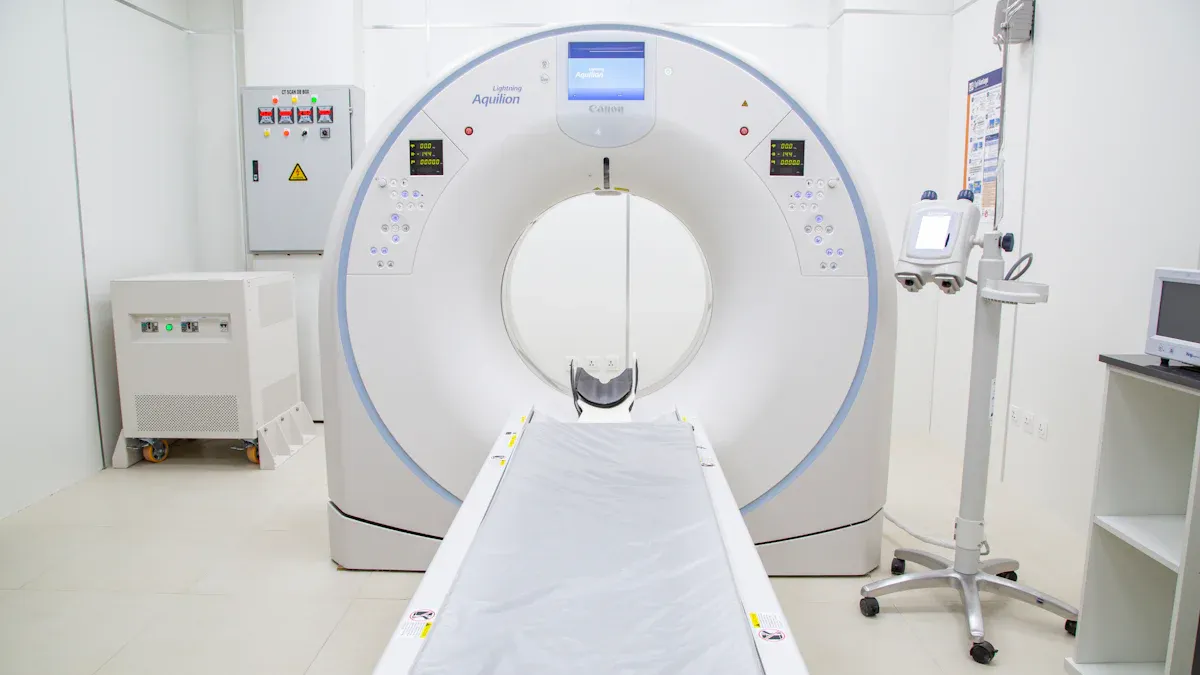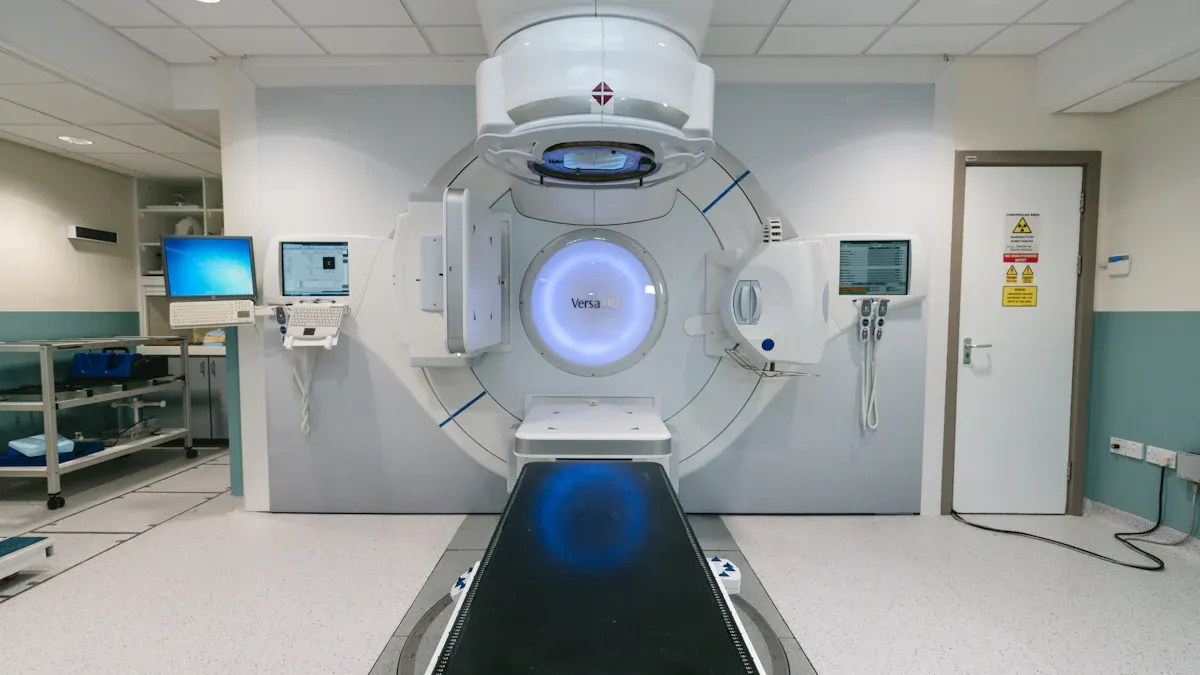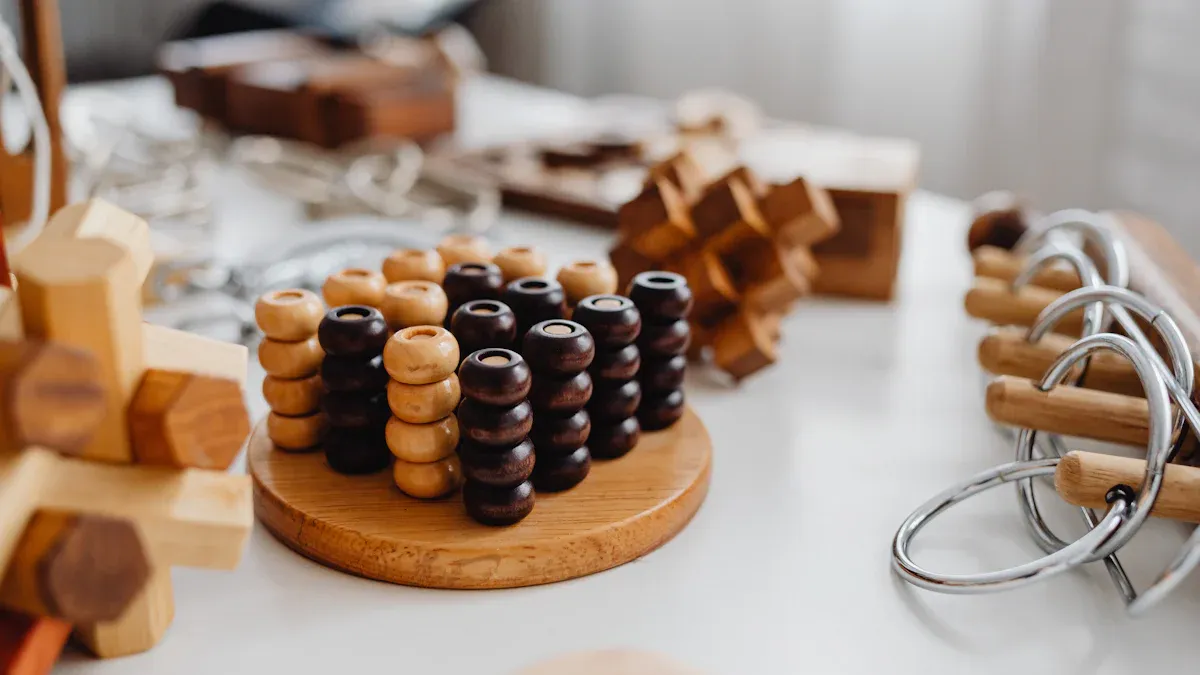
Graphite crucibles play a critical role in high-temperature industrial processes, yet their performance often suffers due to erosion and chemical reactions. The application of Carbide (TaC) Coating on Graphite revolutionizes these applications by significantly enhancing crucible durability. Recent advancements show that TaC Coating reduces erosion rates by up to 60%, enabling graphite crucibles to last 8–12 operational cycles compared to the 3–5 cycles of uncoated alternatives. This innovation ensures superior thermal stability and corrosion resistance, making tac coated graphite susceptor and sic coated graphite susceptor indispensable for demanding environments. The adoption of TaC Coating on graphite continues to transform industries reliant on extreme heat and chemical resilience.
Key Takeaways
- Tantalum Carbide (TaC) coating helps graphite crucibles last longer. Coated crucibles can be used 8–12 times, unlike uncoated ones that last 3–5 times.
- TaC coating handles heat well and resists damage, making it great for industries like aerospace and metalwork.
- The Chemical Vapor Deposition (CVD) process adds an even and strong TaC layer to graphite. This improves how it works in tough conditions.
- Using TaC-coated graphite lowers repair costs and saves time. It is worth the higher starting price.
- Working with experts like Ningbo VET Energy Technology Co. gives you top-quality TaC coating for better crucible use.
Graphite Crucibles and Their Challenges

Why Graphite is Used in Crucibles
Graphite remains a preferred material for crucibles due to its exceptional properties. Its excellent thermal conductivity ensures rapid and uniform heating, which is critical for high-temperature industrial processes. This capability allows for efficient melting and prevents localized overheating, which could lead to chemical instability.
- Graphite’s thermal conductivity enables consistent temperature distribution, improving process reliability.
- Its chemical inertness makes it resistant to most acids, alkalis, and salts, ensuring durability in corrosive environments.
- The material withstands extreme temperatures without significant deterioration, making it suitable for demanding applications.
These characteristics make graphite crucibles indispensable in industries such as metallurgy, glass manufacturing, and chemical processing. Their ability to maintain structural integrity under harsh conditions ensures reliable performance over multiple cycles.
Limitations of Graphite in High-Temperature Environments
Despite its advantages, graphite faces challenges in high-temperature settings. Oxidation remains a primary concern, as exposure to oxygen at elevated temperatures can degrade the material. This process reduces the crucible’s lifespan and compromises its structural integrity.
| Limitation Description | Impact on Graphite Performance in High-Temperature Environments |
|---|---|
| Measurement limitations (vapor emission rate, chemical composition, shape characterization) | Hinders validation of experimental findings with plausible theories. |
| Lack of focus on carbon sub-oxides influencing nucleation | Omits potential factors that could affect graphite’s performance. |
| Limited temperature range in experimental setup | Affects understanding of graphite’s oxidation behavior under varying conditions. |
| Unexplored alternative particle generation mechanisms | Misses insights into other processes that could impact particle characteristics. |
Additionally, graphite’s porous structure can absorb impurities, leading to contamination of the materials being processed. These limitations highlight the need for protective coatings, such as Tantalum Carbide (TaC), to enhance graphite’s performance and longevity in extreme environments.
Properties of Tantalum Carbide (TaC) Coating on Graphite

Chemical Stability and Corrosion Resistance
Tantalum Carbide (TaC) coating on graphite exhibits remarkable chemical stability, making it highly resistant to corrosive environments. This property is particularly beneficial in applications involving reactive chemicals or extreme conditions. The coating forms a protective barrier that prevents chemical reactions between the graphite substrate and external agents.
Note: TaC-coated graphite materials have been tested in environments simulating the growth of aluminum nitride single crystals, demonstrating their ability to resist corrosion effectively.
| Evidence Type | Description |
|---|---|
| Chemical Stability | TaC-coated graphite materials remain stable under harsh chemical conditions. |
| Corrosion Resistance | Tests show excellent performance in corrosive environments, such as NH₃ exposure. |
| Production Method | The TRD process ensures thermodynamic feasibility and optimal coating quality. |
The coating’s ability to withstand corrosive agents ensures the longevity of graphite crucibles, reducing maintenance costs and enhancing operational efficiency.
Thermal Shock Resistance
Thermal shock resistance is a critical property for materials used in high-temperature applications. Tantalum Carbide (TaC) coating significantly improves the thermal shock resistance of graphite crucibles by minimizing the risk of cracking or structural failure during rapid temperature changes.
- Key Features of TaC Coating:
- Maintains structural integrity during sudden heating or cooling cycles.
- Prevents surface cracks and erosion under extreme thermal conditions.
Ablation tests conducted under an oxyacetylene flame for 120 seconds revealed that the TaC coating remained intact, with negligible erosion and no surface cracks. This performance highlights its ability to endure thermal stress without compromising functionality.
High-Temperature Durability
Tantalum Carbide (TaC) coating enables graphite crucibles to operate at temperatures exceeding 2200°C, far surpassing the capabilities of alternative coatings like silicon carbide (SiC). The coating’s high hardness (18.635 GPa) and elastic modulus (288.7 GPa) contribute to its exceptional durability under extreme heat.
| Property | TaC Coating | SiC Coating | Bare Graphite |
|---|---|---|---|
| Max Temperature | >2200°C | <1600°C | ~2000°C (with degradation) |
| Etch Rate in NH₃ | 0.2 µm/hr | 1.5 µm/hr | N/A |
| Impurity Levels | <5 ppm | Higher | 260 ppm oxygen |
| Thermal Shock Resistance | Excellent | Moderate | Poor |
The coating’s ability to maintain its integrity under extreme temperatures ensures consistent performance and reduces the risk of material failure. Its superior thermal properties make it indispensable for industries requiring high-temperature processing, such as aerospace and metallurgy.
The Science Behind Tantalum Carbide (TaC) Coating on Graphite
Protective Mechanisms of TaC Coating
Tantalum Carbide (TaC) coating acts as a robust shield for graphite crucibles, protecting them from the harsh conditions of high-temperature industrial processes. This coating forms a dense, impermeable layer over the graphite surface, effectively preventing oxygen and other reactive elements from penetrating the substrate. By doing so, it mitigates oxidation, which is one of the primary causes of graphite degradation.
The coating’s high hardness and chemical inertness further enhance its protective capabilities. It resists mechanical wear and chemical reactions, even in environments where uncoated graphite would quickly erode. For instance, in metallurgical applications, molten metals and slags often attack crucible materials. The TaC coating prevents such interactions, ensuring the graphite retains its structural integrity.
Additionally, the coating minimizes contamination risks. Graphite’s porous nature can absorb impurities, which may compromise the purity of the processed materials. The TaC layer seals these pores, creating a barrier that maintains the crucible’s cleanliness and performance.
Interaction with High-Temperature and Corrosive Environments
The performance of Tantalum Carbide (TaC) coating on graphite in extreme environments is a testament to its advanced material properties. At temperatures exceeding 2200°C, the coating remains stable, maintaining its protective qualities without melting or degrading. This thermal stability is crucial for industries like aerospace and semiconductor manufacturing, where consistent performance under extreme heat is non-negotiable.
In corrosive environments, the coating’s chemical resistance becomes evident. For example, in processes involving ammonia or molten salts, uncoated graphite would react and deteriorate rapidly. The TaC coating, however, resists these aggressive agents, ensuring the crucible’s longevity.
Note: The coating’s ability to withstand both high temperatures and corrosive chemicals makes it a versatile solution for a wide range of industrial applications.
The interaction between the coating and its environment also highlights its role in reducing maintenance costs. By extending the lifespan of graphite crucibles, the coating minimizes the need for frequent replacements, offering both economic and operational benefits.
Application Techniques for Tantalum Carbide (TaC) Coating on Graphite
Overview of the Chemical Vapor Deposition (CVD) Process
The Chemical Vapor Deposition (CVD) process is a widely adopted method for applying Tantalum Carbide (TaC) coatings on graphite. This technique involves the chemical reaction of gaseous precursors, which deposit a thin, uniform layer of TaC onto the graphite substrate. The process occurs in a controlled environment, ensuring precision and consistency in the coating’s quality.
CVD offers several advantages for TaC coating applications. It produces a dense and adherent layer that enhances the graphite’s resistance to high temperatures and corrosive environments. The method also allows for precise control over the coating’s thickness, ensuring optimal performance in demanding industrial conditions.
A comparative study highlights the benefits of CVD in achieving superior coating quality. For instance, TaC-coated graphite filaments exposed to SiH₄ retained their shiny golden appearance, while tungsten wires became swollen and discolored. Additionally, the deposition rate for TaC coatings achieved through CVD showed a twofold increase, demonstrating the process’s efficiency.
| Feature | TaC-coated Graphite Filament | W Wire |
|---|---|---|
| Appearance after SiH₄ exposure | Retains shiny golden color | Becomes swollen and discolored |
| Chemical stability | Temperature-independent | Not temperature-independent |
| Deposition rate | ~2× increase | N/A |
Key Parameters Influencing Coating Quality
Several critical parameters influence the quality of TaC coatings applied through the CVD process. These parameters determine the coating’s adhesion, uniformity, and overall performance.
- Powder Feed Rate (PFR): Controls the amount of coating material supplied during the process.
- Stand Off Distance (SOD): Regulates the distance between the spray gun and the graphite substrate, ensuring even deposition.
- Lambda (λ): Maintains specific combustion conditions by controlling the oxygen-to-fuel ratio.
- Coating Velocity (CV): Determines the deposition rate, influenced by the speed of robotic arms or lathes.
- Total Gas Flow (TGF): Governs the flow rate of combustion gases, ensuring a stable and efficient coating process.
| Parameter | Description |
|---|---|
| Powder Feed Rate (PFR) | Governs the amount of coating material supplied. |
| Stand Off Distance (SOD) | Regulates the spacing between the spray gun and the substrate. |
| Lambda (λ) | Ensures specific combustion conditions by controlling the stoichiometric ratio of oxygen to fuel. |
| Coating Velocity (CV) | Enables precise control over the deposition process, influenced by robot traverse speed and lathe speed. |
| Total Gas Flow (TGF) | Governs the overall flow rate of combustion gases, constituted by the summed gas flow of fuel, oxygen, and air. |
By optimizing these parameters, manufacturers can achieve a high-quality TaC coating that enhances the performance and lifespan of graphite crucibles in extreme environments.
Experimental Findings and Performance Metrics
Effects of Coating Thickness on Crucible Lifespan
The thickness of the Tantalum Carbide (TaC) coating plays a pivotal role in determining the lifespan of graphite crucibles. Experimental trials reveal that a coating thickness of approximately 150 µm offers optimal performance. This thickness ensures a robust protective layer that resists oxidation and wear without compromising the structural integrity of the crucible.
Thicker coatings provide enhanced durability by forming a more substantial barrier against high-temperature erosion and chemical attacks. However, excessively thick coatings may introduce stress during thermal cycling, potentially leading to cracking. Conversely, thinner coatings may fail to provide adequate protection, reducing the crucible’s operational lifespan.
By achieving the ideal balance in coating thickness, manufacturers can significantly extend the service life of graphite crucibles, reducing the frequency of replacements and operational downtime.
Corrosion Resistance and Adhesion Strength
The corrosion resistance and adhesion strength of TaC coatings are critical for their performance in harsh industrial environments. TaC-coated graphite exhibits exceptional resistance to chemical degradation, even in highly reactive environments such as ammonia or molten salts. This resistance ensures that the crucible maintains its structural integrity and functionality over extended periods.
The adhesion strength of the coating to the graphite substrate is equally important. Strong adhesion prevents delamination or peeling, which could expose the underlying graphite to corrosive agents. Experimental findings confirm that TaC coatings adhere firmly to graphite surfaces, even under extreme thermal and chemical conditions.
| Performance Metric | Experimental Findings |
|---|---|
| Oxidation Resistance | TaC coatings significantly improve oxidation resistance, enhancing potential applications in extreme environments. |
| High-Temperature Tolerance | A 150 µm thick TaC coating remained intact without cracking after treatment at 2000°C, demonstrating high-temperature tolerance. |
| Wear Resistance | Increased carbon content in the coating led to a decreased friction coefficient, indicating excellent wear resistance. |
| Chemical Stability | TaC coating particles showed good chemical stability and high-temperature stability after treatment at 2000°C. |
| Ablation Resistance | The TaC coating exhibited excellent ablation resistance and maintained high structural stability under extreme temperatures. |
These properties make TaC-coated graphite a reliable choice for industries requiring high-performance materials.
Performance in Extreme Thermal Conditions
TaC-coated graphite demonstrates unparalleled performance in extreme thermal environments. The coating remains stable at temperatures exceeding 2200°C, far beyond the capabilities of uncoated graphite. This stability ensures that the crucible can withstand rapid temperature changes without cracking or degrading.
- Key Performance Highlights:
- TaC-coated graphite wafer carriers exhibit exceptional thermal stability and chemical resistance, making them suitable for high-temperature applications.
- The coating enhances durability, thermal resistance, and chemical stability, which are essential for extreme thermal conditions.
These attributes make TaC-coated graphite indispensable for industries such as aerospace, metallurgy, and semiconductor manufacturing, where materials must endure extreme heat and chemical exposure.
Industrial Applications and Practical Implications
Benefits for High-Temperature Industries
Tantalum Carbide (TaC) coatings on graphite have revolutionized high-temperature industries by addressing critical challenges. These coatings enhance the performance of graphite crucibles in sectors such as aerospace, metallurgy, and semiconductor manufacturing. Their ability to withstand extreme temperatures and resist chemical corrosion ensures reliable operation in demanding environments.
In aerospace applications, TaC-coated graphite components endure the intense heat generated during propulsion and re-entry phases. This durability reduces the risk of material failure, ensuring safety and efficiency. Metallurgical processes benefit from the coating’s resistance to molten metals and slags, which extends the lifespan of crucibles and minimizes contamination. Semiconductor manufacturing also relies on the coating’s thermal stability to maintain precision during wafer production.
The adoption of TaC coatings has significantly improved operational efficiency across these industries. By reducing material degradation, these coatings lower maintenance requirements and enhance productivity.
Cost-Effectiveness and Long-Term Value
The application of Tantalum Carbide coatings offers substantial cost savings over time. Although the initial investment in coated graphite crucibles may be higher, the extended lifespan and reduced maintenance costs provide long-term value. Industries that rely on high-temperature processes often face frequent equipment replacements due to wear and tear. TaC coatings mitigate this issue by protecting the graphite substrate from erosion and chemical damage.
The reduced need for replacements translates to lower operational downtime, which is critical for industries with continuous production cycles. Additionally, the coating’s ability to maintain material purity minimizes product defects, further enhancing cost-effectiveness. These benefits make TaC coatings a practical choice for businesses seeking to optimize their resources.
Ningbo VET Energy Technology Co.’s Role in Providing TaC Coating Solutions
Ningbo VET Energy Technology Co., Ltd has established itself as a leader in delivering advanced Tantalum Carbide coating solutions. The company specializes in producing high-quality graphite products tailored to meet the needs of high-temperature industries. Its expertise in applying TaC coatings ensures superior performance and durability for graphite crucibles.
By leveraging cutting-edge technology and rigorous quality control, Ningbo VET Energy Technology Co. provides reliable solutions that address the challenges of extreme industrial environments. The company’s commitment to innovation and customer satisfaction has made it a trusted partner for businesses worldwide.
Tip: Partnering with a reputable provider like Ningbo VET Energy Technology Co. ensures access to state-of-the-art TaC coating solutions, maximizing the value of your investment.
Tantalum Carbide (TaC) coating has revolutionized the durability and performance of graphite crucibles. Its unmatched thermal stability, corrosion resistance, and high-temperature durability make it an essential solution for industries operating in extreme environments. Advanced application techniques, such as the Chemical Vapor Deposition process, ensure precise and reliable coatings that extend crucible lifespan while reducing operational costs.
Ningbo VET Energy Technology Co. continues to lead the industry by delivering cutting-edge solutions tailored to meet the demands of high-temperature applications. Their expertise in producing high-quality graphite products with TaC coatings ensures superior performance and long-term value for industrial clients worldwide.
FAQ
What makes Tantalum Carbide (TaC) coating superior for graphite crucibles?
Tantalum Carbide (TaC) coating offers unmatched thermal stability, corrosion resistance, and durability. It protects graphite crucibles from oxidation and chemical erosion, extending their lifespan significantly. These properties make it ideal for high-temperature industrial applications.
How does TaC coating improve the lifespan of graphite crucibles?
TaC coating forms a dense, protective layer that shields graphite from oxidation, chemical reactions, and thermal stress. This barrier reduces wear and tear, allowing crucibles to last up to three times longer than uncoated alternatives.
What industries benefit most from TaC-coated graphite crucibles?
Industries such as aerospace, metallurgy, and semiconductor manufacturing benefit greatly. These sectors require materials that can withstand extreme temperatures and corrosive environments, making TaC-coated graphite crucibles indispensable.
How is the TaC coating applied to graphite?
The Chemical Vapor Deposition (CVD) process is commonly used. This method ensures a uniform, adherent TaC layer on the graphite surface, optimizing its performance in demanding conditions.
Why choose Ningbo VET Energy Technology Co. for TaC coating solutions?
Ningbo VET Energy Technology Co. specializes in high-quality graphite products with advanced TaC coatings. Their expertise and cutting-edge technology ensure reliable, durable solutions tailored to high-temperature industrial needs.






